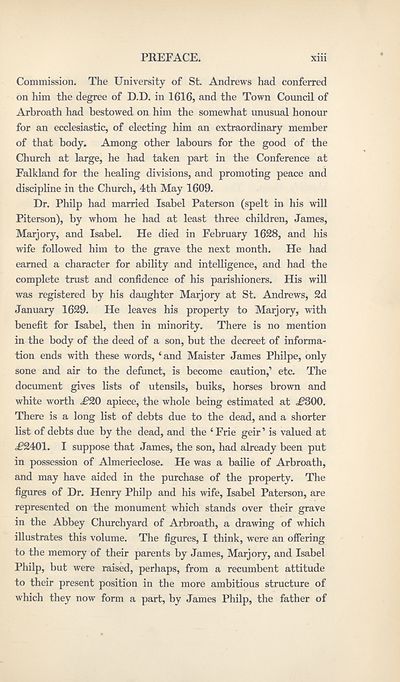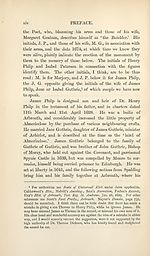Series 1 > Grameid: an heroic poem descriptive of the campaign of Viscount Dundee in 1689, and other pieces
(26) Page xiii
Download files
Complete book:
Individual page:
Thumbnail gallery: Grid view | List view

PREFACE.
xiii
Commission. The University of St. Andrews had conferred
on him the degree of D.D. in 1616, and the Town Council of
Arbroath had bestowed on him the somewhat unusual honour
for an ecclesiastic, of electing him an extraordinary member
of that body. Among other labours for the good of the
Church at large, he had taken part in the Conference at
Falkland for the healing divisions, and promoting peace and
discipline in the Church, 4th May 1609.
Dr. Philp had married Isabel Paterson (spelt in his will
Piterson), by whom he had at least three children, James,
Marjory, and Isabel. He died in February 1628, and his
wife followed him to the grave the next month. He had
earned a character for ability and intelligence, and had the
complete trust and confidence of his parishioners. His will
was registered by his daughter Marjory at St. Andrews, 2d
January 1629. He leaves his property to Marjory, with
benefit for Isabel, then in minority. There is no mention
in the body of the deed of a son, but the decreet of informa¬
tion ends with these words, ‘and Maister James Philpe, only
sone and air to the defunct, is become caution,’ etc. The
document gives lists of utensils, buiks, horses brown and
white worth <£*20 apiece, the whole being estimated at i?300.
There is a long list of debts due to the dead, and a shorter
list of debts due by the dead, and the ‘ Erie geir’ is valued at
J?2401. I suppose that James, the son, had already been put
in possession of Almerieclose. He was a bailie of Arbroath,
and may have aided in the purchase of the property. The
figures of Dr. Henry Philp and his wife, Isabel Paterson, are
represented on the monument which stands over their grave
in the Abbey Churchyard of Arbroath, a drawing of which
illustrates this volume. The figures, I think, were an offering
to the memory of their parents by James, Marjory, and Isabel
Philp, but were raised, perhaps, from a recumbent attitude
to their present position in the more ambitious structure of
which they now form a part, by James Philp, the father of
xiii
Commission. The University of St. Andrews had conferred
on him the degree of D.D. in 1616, and the Town Council of
Arbroath had bestowed on him the somewhat unusual honour
for an ecclesiastic, of electing him an extraordinary member
of that body. Among other labours for the good of the
Church at large, he had taken part in the Conference at
Falkland for the healing divisions, and promoting peace and
discipline in the Church, 4th May 1609.
Dr. Philp had married Isabel Paterson (spelt in his will
Piterson), by whom he had at least three children, James,
Marjory, and Isabel. He died in February 1628, and his
wife followed him to the grave the next month. He had
earned a character for ability and intelligence, and had the
complete trust and confidence of his parishioners. His will
was registered by his daughter Marjory at St. Andrews, 2d
January 1629. He leaves his property to Marjory, with
benefit for Isabel, then in minority. There is no mention
in the body of the deed of a son, but the decreet of informa¬
tion ends with these words, ‘and Maister James Philpe, only
sone and air to the defunct, is become caution,’ etc. The
document gives lists of utensils, buiks, horses brown and
white worth <£*20 apiece, the whole being estimated at i?300.
There is a long list of debts due to the dead, and a shorter
list of debts due by the dead, and the ‘ Erie geir’ is valued at
J?2401. I suppose that James, the son, had already been put
in possession of Almerieclose. He was a bailie of Arbroath,
and may have aided in the purchase of the property. The
figures of Dr. Henry Philp and his wife, Isabel Paterson, are
represented on the monument which stands over their grave
in the Abbey Churchyard of Arbroath, a drawing of which
illustrates this volume. The figures, I think, were an offering
to the memory of their parents by James, Marjory, and Isabel
Philp, but were raised, perhaps, from a recumbent attitude
to their present position in the more ambitious structure of
which they now form a part, by James Philp, the father of
Set display mode to:
![]() Universal Viewer |
Universal Viewer | ![]() Mirador |
Large image | Transcription
Mirador |
Large image | Transcription
Images and transcriptions on this page, including medium image downloads, may be used under the Creative Commons Attribution 4.0 International Licence unless otherwise stated. ![]()
| Scottish History Society volumes > Series 1 > Grameid: an heroic poem descriptive of the campaign of Viscount Dundee in 1689, and other pieces > (26) Page xiii |
|---|
| Permanent URL | https://digital.nls.uk/126595869 |
|---|
| Attribution and copyright: |
|
|---|
| Description | Over 180 volumes, published by the Scottish History Society, containing original sources on Scotland's history and people. With a wide range of subjects, the books collectively cover all periods from the 12th to 20th centuries, and reflect changing trends in Scottish history. Sources are accompanied by scholarly interpretation, references and bibliographies. Volumes are usually published annually, and more digitised volumes will be added as they become available. |
|---|


